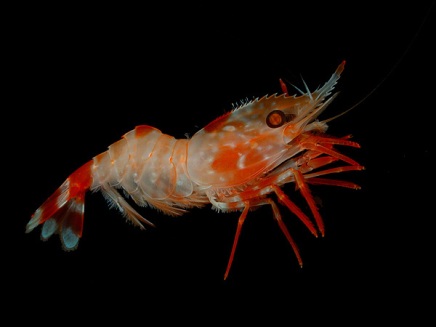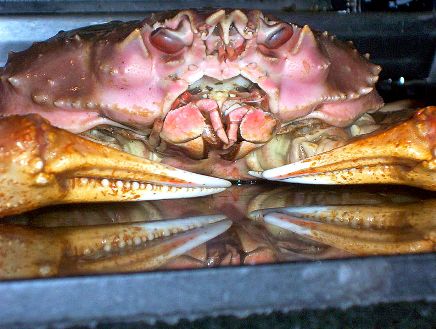Nutrition
The snow crab eats many different organisms including fellow members of the same species!
Diet
Adult
Snow crabs are heterotrophs, meaning they are consumers and hunt to find their nutrient source. They serve as predators for organisms such as fish, polychaete worms, sea brittles, shrimp, clams, or any other organisms that can be found within the muddy substrate that the snow crabs live on. Mainly the female gender, also perform cannibalism at times, meaning they prey on organisms of their same species. Even though Chionoecetes opilio is mainly carnivorous, it is technically a scavenger and will eat almost anything it can find and access.
Larva
When in their larval stage, snow crabs feed on the larva of organisms such as oysters and shrimp. They continue feeding on these until they reach the adult size which is after about four molts.
Temperature and Feeding Habits
Snow crabs are very
temperature sensitive. Their digestive metabolism does not
function properly above temperatures of twelve degrees Celsius, and
therefore the nutrient uptake of snow crabs decreases
drastically or comes to a stop at these temperatures. This is
due to the rising metabolic rates which are more energy costly than
the caloric intake can provide for. Also, many species that
belong in the main diet of
Chionoecetes opilio are not found
at temperatures exceeding twelve degrees Celcius.

Digestion
Chionoecetes opilio capture their prey through the use of their chelipeds (front claws). These chelipeds then transfer the food source to the mouth. During development, the cuticle lines the intestinal tract of the snow crab. This cuticle creates a set of hard teeth in the head region of the crab, which allows for efficient chewing and grinding of materials to increase the surface area and receive as many nutrients as possible. The mouth of the snow crab has three sets of jaws, one for holding the food while the other two grind the materials. Chionoecetes opilio also possess a double stomach, intestinal tract, and an anus. The double stomach is used to pulverize and break down the food source. The second stomach possesses digestive enzymes and juices that help with breaking down the food. The intestines are utilized as another means of nutrient uptake. The intestinal system is fairly short, due to the fact that the snow crab is primarily a carnivore, and consumes food sources with high nutritional value. It is lined with finger-like projections called villi, which create greater surface area for optimal nutrient uptake. Indigestible materials are then passed through the anus and out of the crab's body.
Circulatory System
Snow crabs have an open circulatory system which means the circulatory fluid is hemolymph and is not completely contained within vessels. The hemolymph is transported past the gills where oxygen is taken up and carbon dioxide is released. It is then transported to important areas of the body (major organs) where the hemolymph completely bathes the organs in oxygenated fluid. This fluid is then transferred back to the heart, and the cycle is repeated.
<Adaptation Home Reproduction>
